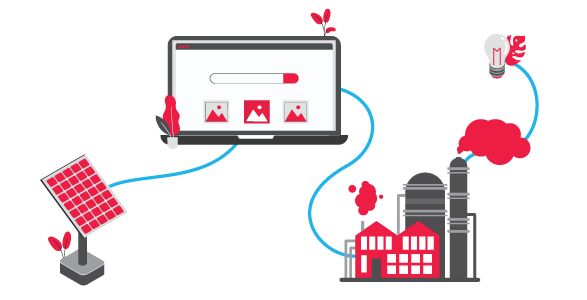Planet First Webdesign
How can the internet become more sustainable?
Pupils go to demonstrations on Friday, office heroes drink their sustainable coffee from reusable to-go cups and even grandma and grandpa give up their annual Scandinavian cruise - sustainability is in vogue.
While in the analogue world we now check almost everything for climate and environmental compatibility, our second home - the internet - remains quite untouched by this. And this despite the fact that digital activities have a major impact on the environment:
or
Before my research on this topic, I honestly thought little about it. With the "Carbonanalyzer" plugin for Firefox I then tracked a normal working day. The result: I used about 0.5 kWh and 223 g CO2e. That's about the same amount of CO2e as it takes to make 35 cups of coffee - to stick with the office example. This does not even include the daily Spotify stream.
A similar result can be achieved with the online tool from Websitecarbon, which clearly calculates the impact of every website on the climate. To offset the CO2 emissions of www.namics.com, we would have to plant three trees every year.
Every single downloaded bit of a website, every Google search or even a simple email ends up in a large, energy-intensive data centre somewhere in the world - and thus causes a CO2 footprint.

So it's kind of ironic that I published an article on digital sustainability on a digital medium. Because this article too will probably end up in a data archive at some point and continue to consume energy unnecessarily. But I don't want to preach about digital sustainability here - it's more about creating awareness for this topic and giving you some food for thought.
Dear bamboo-strawed back-enders, bicycle-riding front-enders and Demeter-loving designers, I have to disappoint you: We will not achieve the Paris climate targets by turning all our buttons green. In fact, there are currently no development or design standards that take digital sustainability into account. Rather, it's small things that we take into account in the development of digital products, sometimes for other reasons:
- Findability & Navigation: The easier a content is to find, the fewer pages need to be loaded. As a result, fewer server requests are made and unnecessary page elements - such as photos and videos that take up a lot of bandwidth - are not loaded at all. This also includes a sensible information architecture, the simplest possible navigation and search engine optimization. These small energy savings add up over time.
- Performance & Optimization: Sustainability and side speed go hand in hand. If a website works efficiently, it consumes less computing power, i.e. less energy - and leaves a smaller CO2 footprint. So the key is to eliminate ballast in the code and unnecessary content from the page. Users expect content to be immediately visible and pages to load quickly anyway.
- Infrastructure & Hosting: The most effective method for a more sustainable website is to switch to a hosting provider that runs its servers exclusively on renewable energy. A (probably still incomplete) overview can be found here.
What else? That's it? Is that all we can do? That's what I asked myself and I wouldn't be a child of Generation Y if I didn't throw some critical questions into the room at this point:
- Do we need a label for "green websites"? The Blue Angel, the eco-label of the German government has been awarded to environmentally friendly products and services for 40 years. Based on the "Ecodesign Directive" of the European Union, the label for "resource- and energy-efficient software products" has been available for the first time since January 2020. So why not develop a label that distinguishes sustainable websites?
- Why don't we include energy consumption as a key figure in the next website relaunch? We could include website climate targets in the next relaunch briefing and use a new benchmark for our decisions regarding infrastructure and design. The targets set will also have a positive impact on other areas of more sustainable websites or apps, as described above.
- Do we need a data expiration date? It feels like cloud storage space is inexhaustible. As a result, we're becoming real data messies, storing every file, no matter how unimportant, in the cloud. So why not give a kind of "expiration date" when creating a file or let the user know that his data is "gathering dust" in the cloud?
- Must a website always be accessible? The website of the low-tech magazine is powered by pure solar energy, which means that it is not accessible on rainy days. Of course, this is not a concept for all websites, but why not shut down the website at night when the number of users is low anyway? With an adequate hint, night owls will surely understand this measure.
- Do we need a new role in our agile teams? User-centered design as well as agile and interdisciplinary teams in development already ensure that there is less data waste and that users also use the developed features. Yet nobody thinks about the environment during development. So do you need an ecological expert in addition to the accessibility expert?
Now it's your turn: We can all start with small steps. For example, when was the last time you cleaned up your e-mail box? Please think about the next relaunch if you really need the big stage video teaser with Autoplay.
- Check the climate impact of websites with vivid comparisons.
- Check the page load time, findability and experience of your website.
- Check whether a website is operated with sustainable electricity.
- How green are the big corporations?
- Website powered by solar energy.
- Firefox plugin that tracks energy consumption and CO2 emissions.










